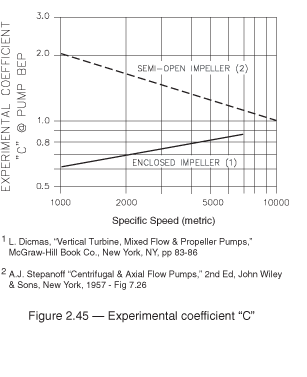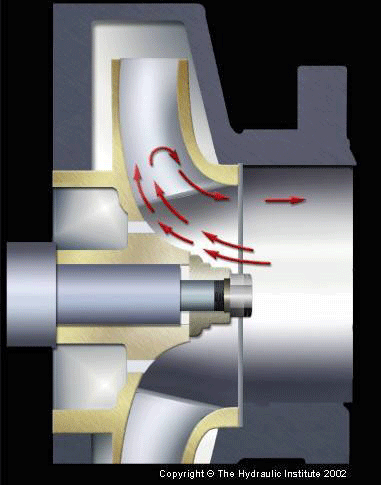Q. Due to a recent thrust bearing failure in one of our deep well pumps, we would like to determine the down thrust on the bearing from the pump. Is there a simple way of calculating this?
A. Following is a simplified version of this calculation, which is found in Hydraulic Institute Standard, ANSI/HI 2.3 Vertical Pump for Design and Application. This equation is for impellers with no back wearing ring and applies to operation at BEP only.
The approximate down thrust at BEP in pounds is calculated as follows:

Figure 2.45 provides the experimental coefficient “C,” which includes the impeller flow momentum change. This coefficient was obtained from a number of tests on vertical pumps, with specific speeds from 1,700 to 12,000. The lines represent an average of these tests. A pump manufacturer’s specific design may have a slightly different “C” value.
Q. I keep hearing about suction recirculation but cannot find a good explanation. Can you help me?
A. When centrifugal pumps are operated at rates of flow below their best efficiency point (BEP), the excess flow produced by the impeller is recirculated on the suction side of the impeller, as shown in Figure 5-12. These eddy currents cause local vortices on the impeller vanes, which in turn cause cavitation that results in noise, vibration, and damage to the impeller vanes.

Figure 5-12. Impeller showing suction recirculation.
This action usually begins between 70 percent and 50 percent of the BEP flow, and many pump manufacturers do not allow operation below the onset of recirculation. Furthermore, some impellers, which are designed for low NPSH Available applications, may begin the recirculation mode close to the BEP. An example of this might be condensate drain pumps in electric power plants.
Q. Pumps designed to handle chemicals are usually made of corrosion resistant materials, but I need to know if there are any other requirements necessary for chemical applications?
A. The following description of requirements for chemical pumps is taken from Section 1.3.3.2.1 in the Hydraulic Institute Standard ANSI/HI 1.3 Centrifugal Pumps for Design and Application.
Pumps used for handling corrosive liquids or slurries are commonly termed chemical pumps. The materials of construction for the parts in contact with the liquid, including stuffing-boxes or seals, must be selected to offer maximum resistance to corrosion and abrasion at the pumping temperature, with due consideration to the economy of such use.
Each application must be carefully scrutinized to determine the severity of corrosion or abrasion, viscosities at the extreme pumping temperatures, the hazard involved in the material to be pumped, changes in the composition of the liquid, true vapor pressure, net positive suction head (NPSH), prolonged operation at or near shut-off, or any other pertinent characteristics of the liquid or the application.
The physical and chemical properties of materials, the available forms, and methods of fabrication must be considered in the design of satisfactory equipment. Dissimilar materials in contact with the liquid pumped should be avoided unless the combination is one, which is known to be satisfactory for the particular service.
Special seals or deep stuffing-boxes, with provision for lubrication or sealing by clear cold water, are frequently necessary. Large unobstructed liquid passages are desirable. The unit should be designed for easy and quick disassembly for inspection, cleaning or repair. Water jackets, steam jackets, or smothering type glands may be mandatory. The need for these features can be determined only after careful consideration of application requirements.
ANSI/ASME B73.1, B73.2, and B73.5 covering specifications for horizontal end suction and vertical in-line pumps for chemical process may be used for more information.
Pumps & Systems, October 2006


